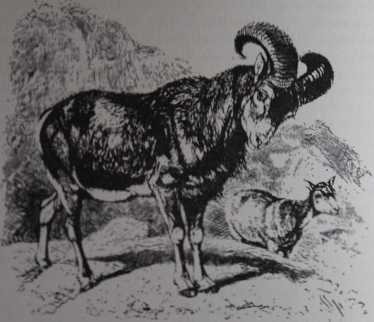IMGR24
DRESSING THE SKINS
bon cilicd Mns*U [Fig. i] no* fbund elscwhcrc in Europę, horned like a Ram and Junned like a Mag, his skin camcd to Corduba and ihcre dressed to make our truć Cordovan Icather.’ The mouflon (to use its English namc), traditionally once indigenous o Spain, ii one of sewral spedes of hair-sheep the pelis of which are superior to those of be common wool-sheep, with just the properties that might be expected to producc achcr a pliablc, durąbie Icather such as ffuiamed was by this datę (1656) when it was

a. Ta «be nimb of Cenią mi Sarinu. there a a boa caU W, noc found ■» ■ Enrope. heraed Ik a Ram. and drinned like a tog, ha duo curied 10
mi dne drened w nule om mm Cordonn leithtr.* Fm T. Bloum. Clu^pfUi. itji
gaable-amied oe, in catłicr times, a good qualiry uwed Icather. Ifihe Libyan leathn was gosnkin (as n Ukdy) the use, in Spain, of hair-sheep would havc been an innovation. On the wbole, k mm reasonable to suppose that in Spain there were considcrable iptOYcments in the qualky of tawed leather, partly it may be from the use of hair-sheep in and pudy from superior methods of dressing. Whilst the basie process of tawing th alum and salt would be unchangcd, the character of the leather could be considerably cred by the subsequent finishing proccsses. Whilst these may have employed andent
16
Wyszukiwarka
Podobne podstrony:
53460 IMGR22 DRESSING THE SKINS (Fig. i). Bul evcn che sofieaod kocher would have very limitcd use w
IMGR25 DRESSING THE SKINS I pcrhapt wdl-known redpes, k is dear ihac ikill and ankoy combincd to pro
IMGR20 Chapter ThreeDRESSING THE SKINS [(bas noc pcevioajły been madę elear chat, in ia origins, che
Supervision for social work in European Union- Gurrent trends and the educational process Jose Reisj
Scan0007 (36) 12 12 Fig.l: MS prevalence raiios in Europę, North Africa and Israel presented in this
Scan0007 (36) 12 12 Fig.l: MS prevalence raiios in Europę, North Africa and Israel presented in this
34693 Scan0007 (36) 12 12 Fig.l: MS prevalence raiios in Europę, North Africa and Israel presented i
o dBFrequency (Hz) l— SO* (high) SD* (Iow) Fig. 2. Mean hearing levels in the ieft
Fig. 1 A table was constructed (hal could be adjusted in height between 75 cm and 100 cm above Lhe f
więcej podobnych podstron